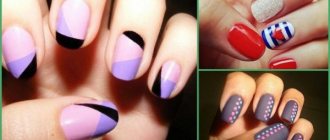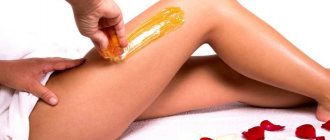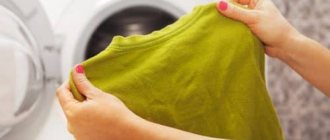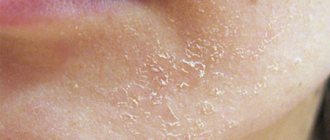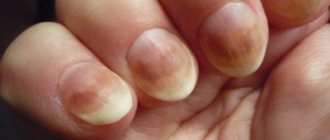A hygienic manicure should become a mandatory regular beauty ritual for every girl, as it is the key to beautiful and well-groomed hands. To do this, it is not necessary to visit a beauty salon every week; you can get a high-quality manicure at home. This not only has an aesthetic function, but also prevents dermatological diseases of the skin of the hands.
The task of a hygienic manicure is to give the desired length and shape to the nail plates, polish them, as well as remove cuticles, hangnails and cracks in the skin around the nail. When visiting a beauty salon, you need to pay attention to the condition of the instruments; you can check with the specialist how they were disinfected. At home, you should also not neglect this step and wipe all tools with an antibacterial agent before each manicure.
Hygienic manicure - what is it?
Manicure is a cosmetic procedure that focuses on the correction of nails and fingers. You can take care of them both in specialized beauty salons and at home. The procedure for performing a manicure makes it possible to maintain the health and beauty of your fingers and nails. We need a manicure procedure so that the nail plates acquire the required shape and equal length, and also to remove cracks and hangnails and eliminate nicks on the nails.
Before a manicure in the salon, the master will suggest steaming your hands in special baths with soapy water. Then he will treat each of your nails. He will file them, straighten them, remove or push back the cuticles.
The specialist will treat the nail plates with cosmetic oil to prevent cracks from appearing on them, and the hygienic manicure process will be completed with a hand massage.
European (unedged) manicure
The peculiarity of this method of nail care is the elimination of the use of cutting tools. Softening and removal of the cuticle is carried out with special removers and an orange stick. It is ideal for short and thin cuticles.
To carry out the procedure, you need a bath, a buff, a file, a pusher or an orange stick, a remover, napkins, bath salts, and a disinfectant.
Technique
- Wash your hands and disinfect them with a special product.
- Trim your nails and give them the desired shape.
- Apply the remover to the cuticle and wait a few seconds.
- Dip your fingers into a bath of warm water and sea salt.
- Remove one finger from the bath and carefully use an orange stick to remove all tissue softened by the remover.
- Apply cuticle oil to your finger. It slows down its growth and moisturizes the nail plate.
In this way, all fingers on the hands are processed sequentially. You can apply cream to your hands. If you want to make a colored coating, before applying polish or gel polish, do not forget to degrease the nail by wiping it with a cotton pad soaked in warm water or a special cleaner.
What is used for the hygienic manicure procedure?
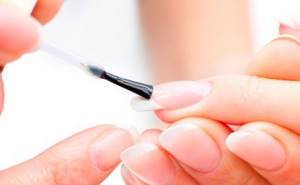
We present a basic list of necessary funds:
- bath with soapy water. You can add liquid scented soap, a few drops of essential oil to the water, and decorate it with flower petals;
- disinfectant. Used to disinfect hand surfaces;
- nail clippers or nail scissors. You can use one or both types of tools. To remove cuticles, you need to use scissors with rounded edges;
- nail files. The types and number of nail files may vary. If you have a multifunctional nail file that has sides for polishing, filing, and adding shine to your nails, then it will be enough. If there is no such file, then different types of files are used;
- cosmetic oil for nails. It provides the necessary minerals, vitamins and protects nails from splitting;
- nail polish removers that do not contain acetone. Allows you to remove old varnish;
- lemon juice. Used to whiten, shine and polish nails. You can also use regular chalk;
- orange stick. In some cases, the cuticle is not removed with scissors, but is pushed back with a stick;
- nail polish. Before covering the nails with decorative varnish, use a base varnish to protect the nail plates, and then use a fixing varnish;
- hand cream. Used to protect the delicate skin of the hands and for massage;
- towel. It is necessary to dry your hands after taking a bath;
- cotton wool, cotton pads and sticks.
What you absolutely need to know and be able to do
Before making big plans and counting future earnings, be patient. This profession, like any other, needs to be learned. Don't expect to acquire all the necessary skills on your own. You can find many video tutorials and useful materials on the Internet, but this is not enough. You should definitely enroll in courses that provide not only a theoretical basis, but also practice. Don’t skimp – give preference to qualified teachers with recommendations and international diplomas. You will need not only money, but also time, because in the case of manicure, skill comes with experience.
However, great desire, perseverance and financial investments are not a guarantee of a good result. The profession of a nail technician is not suitable for everyone. It is necessary not only to bring beauty to the hands of clients, but also to communicate with them, listen to their tastes and wishes. If working with people tires you, it’s better not to start at all. As practice shows, clients most often return to sociable and friendly professionals who know how to create a comfortable atmosphere during the session.
If you are ready to work with people, which is often tiring, and you are not afraid of the pitfalls of the profession, check out the most important skills for a novice master:
- it is necessary to learn how to work with mechanical manicure tools - files, buffs, nippers, scissors, orange sticks and others;
- possession of electrical equipment that a modern master cannot do without - a sterilizer, an ultraviolet lamp, an extractor hood, a device for hardware manicure;
- knowledge of the anatomical features of the structure of the nail plate, nail architecture, basic principles of their processing and design;
- ability to use cosmetics for decorative manicure - primers, gel polishes, extension materials, base and top coats;
- knowledge of sanitary standards and rules that will keep you and your clients healthy, and are prescribed at the legislative level.
At the same time, you should not miss a single point, even if it seems unnecessary to you. Manicure is not only about beauty, but also about safety. It involves contact with the client’s skin, so it requires a careful and attentive approach. This way you will not only delight girls with amazing results on their nails, but also protect them from dangerous diseases.
Hygienic manicure at home
Ungroomed nails and fingers do not make anyone look good. Any woman should take care of her hands. Every week you need to do a hygienic manicure. Let's look at the following steps step by step:
- Hand sanitization process. For this purpose, antiseptic agents are used, which are purchased in cosmetics departments.
- Removing old varnish. You should get rid of it before steaming your pens using a cotton swab dipped in nail polish remover.
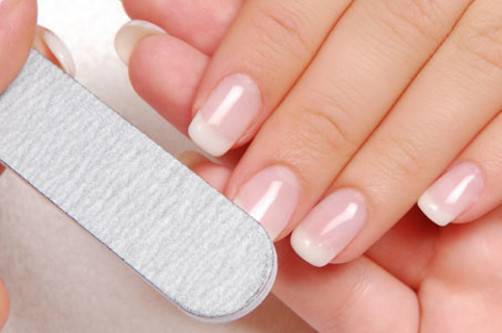
Treatment of nail plates. Using a nail file, you need to give your nails the required shape and length. Dry nails cannot be trimmed with nail clippers or scissors, but can only be filed. It is important to remember that correct filing is a movement from the corner of the nail to its center. If your tool is not very good, then you should file your nails only in one direction to avoid delamination of the nail plates. If cuts or wounds appear on the skin, you must use hydrogen peroxide.- Taking a bath. Use warm water with liquid soap dissolved in it. Lather some water, soak your hands in it for 5-10 minutes, and then use a towel.
- Cuticle treatment. You can remove the cuticle using scissors, a special solution, or using an orange stick to push it back.
- Nail treatment. At this stage, the nails are cleaned of dirt, rough skin and hangnails are removed.
- Polishing nails. This procedure should be done one to two times a month.
- Hand massage. A cream, preferably enriched with calcium, is applied to the fingers, skin of the hands and nails, which will nourish your nails. The massage involves stroking and alternately kneading each finger, hand, and wrist.
- Hand cleansing. It is necessary to wash your hands again in soapy water and dry them.
- Coating the nail plates with varnish. On polished, smooth and even nails, apply a base varnish, and then a colored varnish and a fixing varnish.
Hello, dear beauties! We, Irina and Igor, have once again prepared for you an interesting article on the topic of beauty. Who among you doesn't want to sparkle with your beauty? We don't think there are any like that. But sometimes, even such a small thing as a lack of manicure spoils women’s mood and does not make them feel beautiful.
Meanwhile, in order to get a neat manicure, you don’t have to go to a beauty salon; you can pay attention to it yourself.
And in our article today we will tell you how to quickly do a manicure at home.
Preparing the tools
First you need to prepare all the necessary tools and your “working” place.

Make sure you have on hand:
- Hand bath, sea or cosmetic salt
- Hand or body scrub
- Moisturizing hand cream
- Cuticle oil and sticks for pushing it back
- Nail polish remover and cotton pads
- Various files: for filing lengths, for polishing
- Scissors, tweezers and nippers
- Degreaser - this can be a special product or regular alcohol
- Decorative and clear nail varnishes
You will find a wide selection of different manicure products in the Ozon.ru in the “Beauty and Health” .
Once you have prepared everything you need, you can begin the manicure itself.
Sequencing
Initially, you should carry out a procedure for cleansing your hands and nail plates. For brushes, a small scrubbing procedure is required.
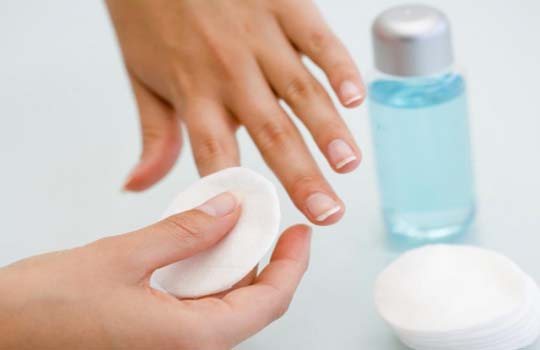
Afterwards, you should remove the old varnish using a special liquid. And then take care of the length and shape of your nails.
If you want to remove a lot of length, then first use scissors or tweezers. After which your arsenal of nail files will be used. You should work with a file from the edge to the middle, so you should first pay attention to your nails on the sides.
Once you have your nail plates in the desired shape, use a buffing file across the entire width of the plate to make the surface smoother. This procedure will help you apply the polish evenly on your nails in the future.
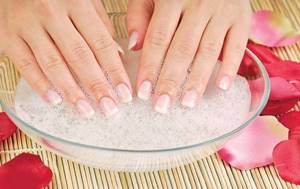
Then you should prepare a hand bath with sea or any other cosmetic salt, and leave your hands to soak for fifteen minutes. After that, take your hands out and pat them dry with a towel so that there is no moisture left on them. Rub a drop of oil into the cuticle.
Depending on what kind of manicure you want to do: edged or unedged, the following order of your actions will depend.
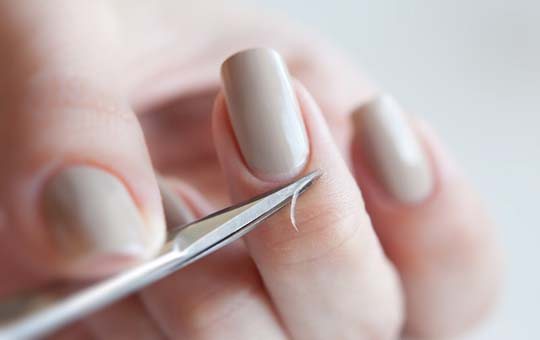
When trimming a manicure, burrs and cuticles are removed using special nippers. When untrimmed, the cuticle is moved back with the help of special sticks.
After completing these steps, you need to treat the nail plates with a degreaser, and at the same time remove any remaining unabsorbed oil.
When the nails are disinfected, you can begin to apply the varnish directly to the nail plate.
First, a colorless base is applied to the nail, which protects the nail from damage and penetration of the coloring pigment into the upper layers of the nail. Next the color coating is applied.
Here, only your imagination can help you determine the design. After the color base has dried, clear varnish is applied again to fix and protect the color.
At the end of the manicure, apply a little moisturizer to your brushes.
Coloring ideas
In this section we have collected for you several color solutions for the design of your nails. This can be painting with several colors, when each nail has its own shade, or when several nails stand out with their own color scheme.

You can also paint your nails with a gradient. To do this, on one nail, for example, on the nail plate of the thumb, varnish is applied in a constant color, and for subsequent nails, the varnish is mixed with white varnish in a separate place. As the white varnish is removed, more and more must be added to achieve a gradient effect.
A good solution for a home manicure would be to apply a French manicure, which always remains in fashion and is modified only by its color schemes.
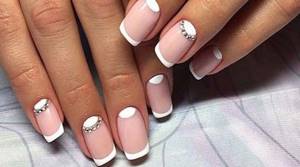
Lately, lunar manicure has also become popular. Here, unlike in French, it is not the tip of the nail that stands out, but its hole. The hole may remain unvarnished or stand out in a different color. You can also apply a combination of French and moon manicures.
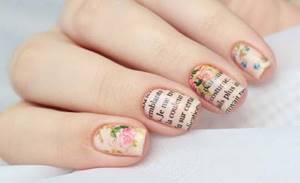
A newspaper manicure is an original design solution, when a printed image of a newspaper or magazine is transferred to the nail using alcohol.
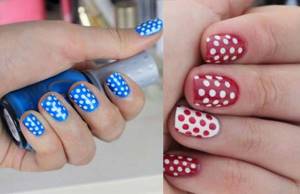
For those who are mastering the basics of nail design, it will be easiest to depict a pattern using “polka dots.” Your hair bobby pin can be used for this. Just dip one end of it in varnish and start creating!
Do you do your manicure at home or do you still prefer to use salon services? Share your experience in this direction.
We are always ready to help you become a little more attractive with our advice. See you soon!
Best regards, Irina and Igor
Pros and cons of hardware manicure
Advantages
- Safety. Low risk of injuring the client, especially if he has thin skin and close capillaries, and low risk of infecting the client, since the procedure is sterile.
- Long lasting effect. Thanks to the even cut made by the cutter, “trash” and burrs do not appear on the cuticle. When performing a deep manicure, the cuticle grows more slowly, hands look well-groomed and beautiful longer, so correction can be done after 3 - 4 weeks.
- Convenience. For work you will only need cutters. There is no need to wrap your nails in foil to remove gel polish, or soak your hands in a bath to push back the cuticles and clean off the pterygium.
- Painless. Despite the fact that many clients are frightened by the sound of the device and the ultra-fast revolutions, such a manicure does not cause pain if the technician works correctly.
- Economical. Investments in the purchase of a machine and cutters will pay off in the first month of work if you plan to become a master. You will not need to spend money on regular sharpening of scissors/tweezers, cuticle softener (remover) and other products.
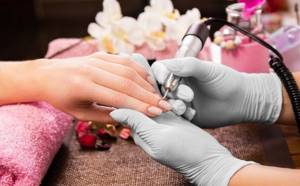
Flaws
In fact, there are few of them if the master has enough experience, knowledge and qualifications. It will be difficult for a beginner at first; he can damage the nail plate and injure himself or the client. The main disadvantages of this technique:
- the difficulty of performing a manicure for a novice master. Therefore, in many schools, they first teach classical and combined manicure, and only then - hardware;
- unpleasant or painful sensations if the procedure is performed by a beginner;
- not recommended for thin nails that are “rags” or neglected rough nails.
For which clients is a hardware manicure suitable?
- For those with rough, fast-growing cuticles.
- For those who are often injured by masters using scissors/tweezers during a classic manicure.
- For those whose nail plate has a dull color.
- For clients who have problematic nails: brittle, flaky, uneven.
- For everyone who values speed and high quality in manicure.
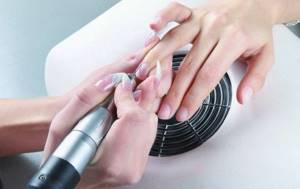
Note! If the nails are affected by fungus, there are cuts, wounds or inflammations, then the client cannot undergo a hardware manicure.
